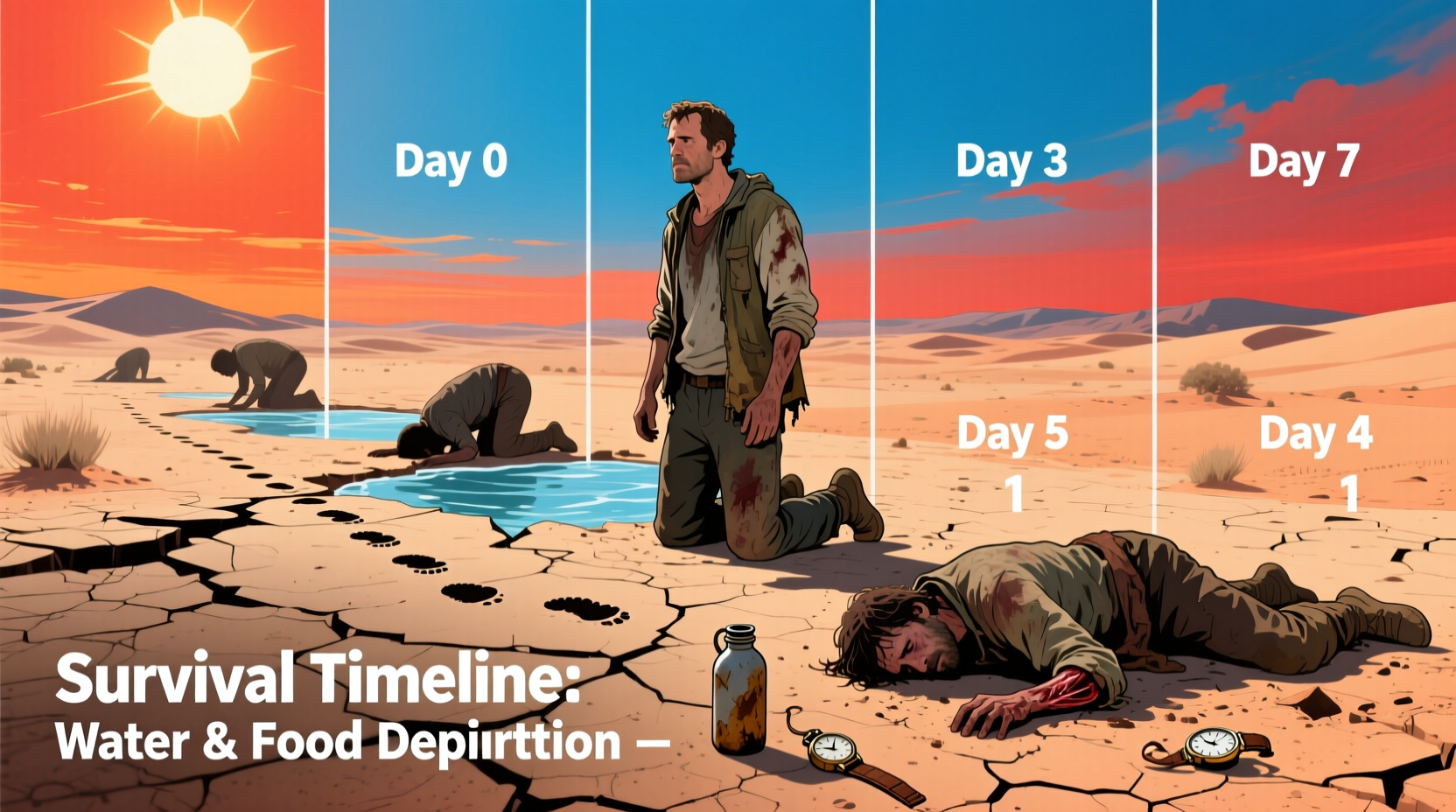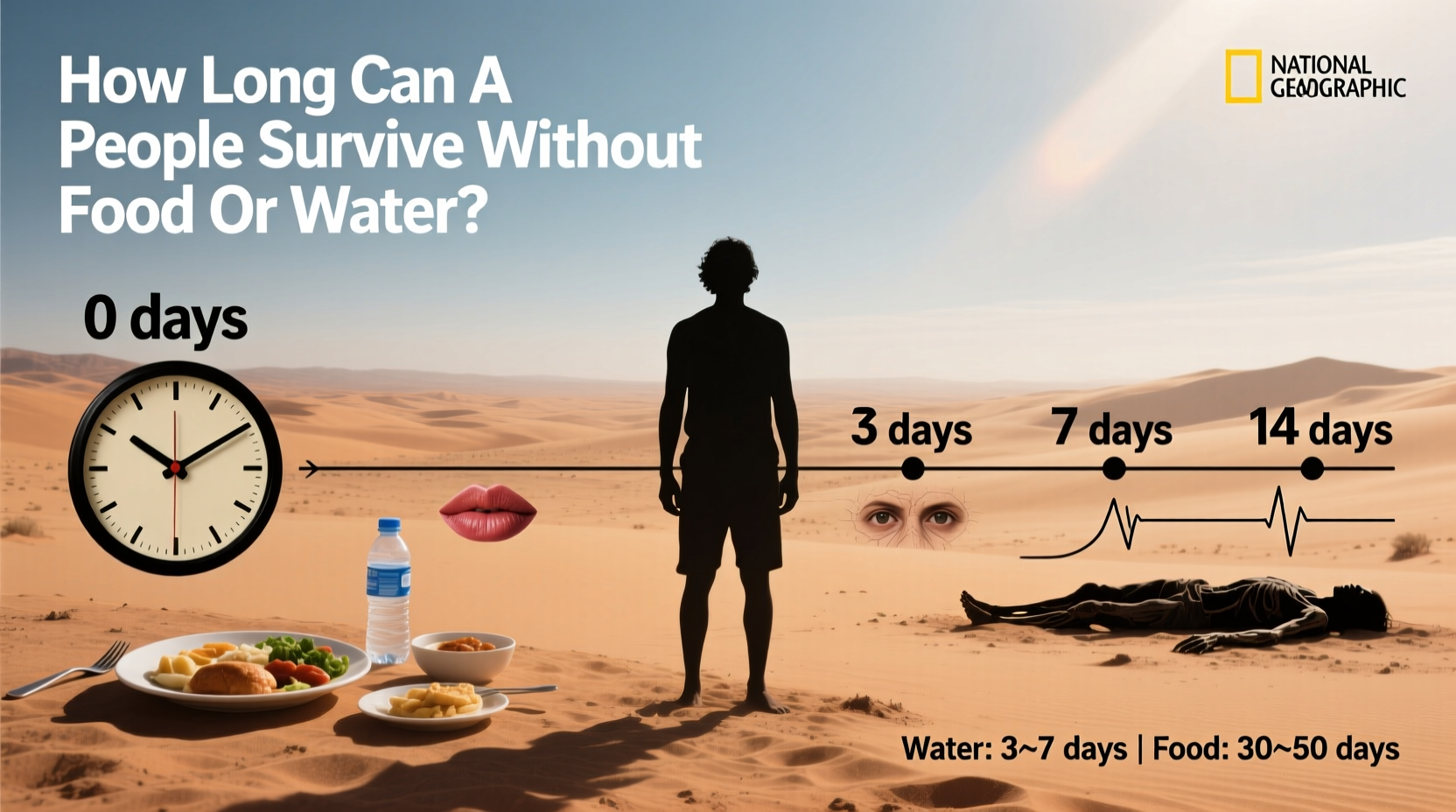Most healthy adults can survive approximately 3-4 days without water and 3-8 weeks without food, though these timelines vary significantly based on environmental conditions, individual health status, and other critical factors. This article provides evidence-based survival timelines, warning signs to recognize, and practical emergency preparedness information.
Understanding Human Survival Limits: What Science Reveals
When facing emergency situations or simply seeking to understand human physiology, knowing precise survival timelines without essential resources is critical knowledge. Unlike dramatic portrayals in movies, real-world survival depends on numerous variables that can dramatically shorten or extend these windows. Understanding these timelines isn't just academic—it could save your life or someone else's during unexpected emergencies.
Water Deprivation: The 72-Hour Critical Window
Water represents the most immediate survival concern. The human body consists of approximately 60% water, and maintaining this balance is essential for nearly every bodily function. Without adequate hydration, systems begin failing rapidly.
| Time Without Water | Physical Effects | Warning Signs |
|---|---|---|
| 12-24 hours | Initial dehydration begins; reduced urine output | Thirst, dry mouth, mild fatigue |
| 24-48 hours | Significant dehydration; reduced blood volume | Dark urine, dizziness, headache, rapid heartbeat |
| 48-72 hours | Severe dehydration; organ stress begins | Confusion, minimal urine, muscle cramps, sunken eyes |
| 72+ hours | Critical organ failure; life-threatening condition | Loss of consciousness, kidney failure, circulatory collapse |
According to research published in the Journal of the American Medical Association, survival beyond 72 hours without water becomes increasingly unlikely under normal conditions. The National Institutes of Health notes that extreme heat can reduce this window to just 24-48 hours, while cooler temperatures might extend it slightly. Your body loses approximately 2-3 liters of water daily through normal functions, which must be replenished to maintain critical physiological processes.

Food Deprivation: Understanding the Longer Timeline
While water represents the immediate threat, food deprivation follows a different physiological timeline. The human body has evolved with significant energy reserves that can sustain function for weeks under certain conditions.
Initially, your body uses stored glucose (glycogen) for energy during the first 24-48 hours. After these reserves deplete, it transitions to ketosis—burning fat stores for energy. This metabolic shift explains why survival without food extends significantly beyond water deprivation timelines. Harvard Medical School research indicates that individuals with higher body fat percentages may survive longer as their bodies have more energy reserves to utilize.
However, complete starvation triggers progressive system failures. After approximately three weeks without food, the body begins breaking down muscle tissue, including heart muscle, significantly increasing health risks. The World Health Organization's famine response guidelines note that children and elderly populations face dramatically reduced survival timelines compared to healthy adults.
Key Variables That Dramatically Alter Survival Timelines
Several critical factors can significantly shorten or extend these standard timelines:
- Environmental temperature: Extreme heat increases water loss through sweating, potentially cutting survival time in half
- Physical activity: Movement increases both water and calorie expenditure, accelerating depletion
- Individual health status: Pre-existing conditions like diabetes dramatically reduce survival windows
- Age factors: Children dehydrate approximately twice as fast as adults; elderly individuals have reduced physiological reserves
- Acclimatization: People adapted to hot climates may survive slightly longer through physiological adaptations
The American Red Cross emergency response guidelines emphasize that in desert environments, survival without water may be limited to just 24-48 hours, while in cool, shaded conditions with minimal activity, some individuals have survived up to 10 days. These variations underscore why generic timelines should serve only as general references rather than absolute guarantees.
Recognizing Critical Warning Signs That Demand Immediate Action
Understanding the progression of symptoms can help determine when emergency intervention becomes critical:
Severe dehydration indicators requiring immediate medical attention:
- No urine output for 12+ hours
- Sunken eyes and extreme dryness of mucous membranes
- Inability to keep eyes open due to dryness
- Confusion or disorientation
- Rapid, weak pulse
Advanced starvation symptoms indicating critical condition:
- Severe muscle wasting
- Edema (swelling) in extremities
- Irregular heartbeat
- Extreme weakness preventing movement
- Low body temperature
The Mayo Clinic emergency medicine department emphasizes that attempting to rapidly rehydrate severely dehydrated individuals can cause dangerous electrolyte imbalances. Medical supervision is essential when addressing advanced dehydration or starvation.
Emergency Preparedness: Practical Steps You Can Take
While hoping never to face such situations, being prepared can make the difference between life and death:
- Maintain an emergency water supply (minimum 1 gallon per person per day)
- Store non-perishable food items with long shelf lives
- Learn basic water purification methods for emergency situations
- Recognize early signs of dehydration to intervene before critical stages
- Understand that small sips of water are more effective than large quantities when rehydrating
According to FEMA's emergency preparedness guidelines, having just a three-day supply of water and food significantly increases survival odds during unexpected emergencies. Remember that water purification tablets and portable filters can dramatically extend your available water resources in survival situations.
Debunking Common Survival Myths
Popular media often misrepresents survival realities. Understanding these misconceptions could prevent dangerous decisions:
- Myth: You can safely drink seawater in emergencies
Reality: Seawater increases dehydration due to its high salt content—never consume without proper desalination - Myth: Eating snow provides adequate hydration
Reality: Consuming snow lowers body temperature and requires energy to melt internally—melt snow before drinking - Myth: You can survive for months without food if you have water
Reality: While water extends the timeline, most healthy adults cannot survive beyond 8 weeks without food due to organ deterioration
The Centers for Disease Control and Prevention consistently warns against attempting to extend survival timelines through unproven methods, emphasizing that professional medical intervention remains critical once severe dehydration or starvation sets in.
How long can a child survive without water compared to an adult?
Children typically survive only 24-36 hours without water—approximately half the timeline of healthy adults. Their higher metabolic rate and surface-area-to-volume ratio causes faster dehydration. Infants face even shorter survival windows, sometimes as little as 12-18 hours in hot conditions.
Can you extend survival time without water by sleeping more?
Yes, reducing physical activity and staying in cool, shaded areas can extend survival time by minimizing water loss through sweat and respiration. The human body uses less water during rest, potentially adding 12-24 hours to the typical 72-hour survival window in optimal conditions.
What's the longest recorded survival without food?
The longest medically documented survival without food was 382 days by Angus Barbieri in 1965-1966 under medical supervision. However, this exceptional case involved an extremely obese individual with substantial fat reserves and constant medical monitoring—not representative of typical survival scenarios.
Does drinking your own urine help extend survival time?
No, drinking urine accelerates dehydration as it contains concentrated waste products your body is trying to eliminate. The American Red Cross explicitly advises against this practice, noting it introduces additional toxins that increase the body's water requirements for processing.











 浙公网安备
33010002000092号
浙公网安备
33010002000092号 浙B2-20120091-4
浙B2-20120091-4